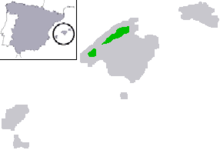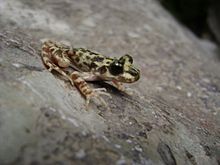- Majorcan midwife toad
-
Majorcan Midwife Toad Conservation status Scientific classification Kingdom: Animalia Phylum: Chordata Class: Amphibia Order: Anura Family: Discoglossidae Genus: Alytes Binomial name Alytes muletensis
Sanchiz & Adrover, 1979
The Majorcan Midwife Toad (also Mallorcan Midwife Toad or Ferreret in Balearic Catalan and Spanish) is an Amphibian of the order Anura and in the family Discoglossidae. It is exclusively endemic to the Balearic Island of Majorca in the Mediterranean Sea. Until 1977 the species was believed to have become extinct, however its consequent discovery meant that the species could be described as a Living Fossil. Although still found in the wild, the Midwife toad can be more commonly be seen in zoos, particularly the Gerald Durrell zoo in Jersey, where it has been quite successfully bred in captivity. The decline of wild populations to a total of about 500 breeding pairs, was caused primarily by the introduction of non-native species to the island hundreds of years ago. Two species in particular being the Green Frog and the Viperine Snake. Reintroduction of the species has taken place since 1988, with many breeding populations now well established in some areas.
Contents
Characteristics
Like all Midwife Toads, the male of the species always carries the developing eggs during the months of May and June. Generally the head and legs are large in comparison to the rest of the body. Unusually, the female of the species competes for the male, even grappling against other individuals in order to secure a mate. Both male and female frogs use a series a noises in order to attract a mate during Courtship. Comparatively the female is larger than the male (Male: 34.7 mm, Female: 38mm).
Distribution
The species is endemic to Majorca, and is found only in the mountainous regions and Gorges of the Sierra de Tramuntana. In this area, the species inhabits streams in limestone caverns, where they hide under boulders and stones.
Status
The Majorcan midwife toad was first discovered in 1977 and was described as Baleaphryne muletensis. Only later the toad was accounted as a midwife toad. This was due to the fact that the species was thought extinct and was described from the fossil record. Later the species was 'rediscovered' in 1979 when froglets and young frogs where discovered. Currently the species is protected as a Majorcan endemic species, and breeding programs have been started to prevent the extinction of this species. The number of wild animals is estimated at around 300 to 700 breeding pairs. One such organisation is the Durrell trust in Jersey.
References
- ^ Serra, J.M et al. (2004). Alytes muletensis. 2006. IUCN Red List of Threatened Species. IUCN 2006. www.iucnredlist.org. Retrieved on 2008-03-23.
- Amphibia Web (February, 2002) http://elib.cs.berkeley.edu/cgi-bin/amphib_query?where-genus=Alytes&where-species=muletensis
- Open University (February, 2002) http://www.open.ac.uk
- Froglog IUCN/SSC Declining Amphibian Populations Task Force. August 1994 No. 10 http://www2.open.ac.uk/biology/froglog/FROGLOG-10.html#xtocid235098
- Durrell Wildlife Conservation Trust (Previously the Jersey Wildlife Preservation Trust) (September, 2002) http://www.durrellwildlife.org/index.cfm?p=60/1
External links
Categories:- IUCN Red List vulnerable species
- Painted frogs
- Amphibians of Europe
- Fauna of the Balearic Islands
Wikimedia Foundation. 2010.


